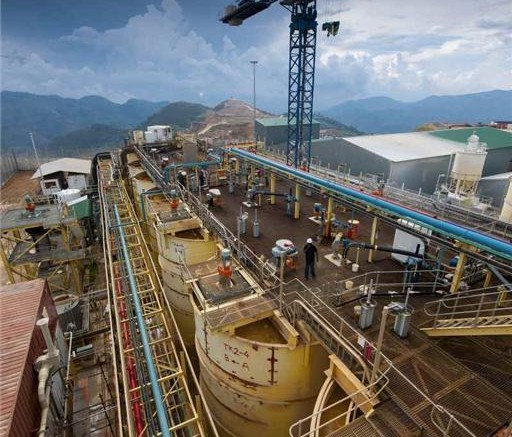Three years ago the area around Banro’s (BAA-T, BAA-N) Twangiza gold deposit in the Democratic Republic of the Congo had no passable roads, power, workable infrastructure or skilled mining labour. Today, the Twangiza oxide mine near the city of Bukavu— the company’s first gold mine along the 210 km Twangiza-Namoya gold belt in the country’s South Kivu and Maniema provinces — officially moved into commercial production.
Initial production at Twangiza is projected at 8,000 oz. per month, but the company is planning a US$10-million to $12-million plant upgrade that could boost that number to more than 10,000 oz. per month. The upgrade would raise the plant’s nominal throughput of 1.3 million tonnes per year up to 2 million tonnes per year. (The upgrade has already been factored into Banro’s capital expenditure program for the next 12 months.)
Andrew Breichmanas of BMO Capital Markets in London described the news as a “significant achievement” demonstrating the Toronto-headquartered company’s “operational and development strengths.”
“Delivering Twangiza is the first milestone as the company advances its pipeline of attractive projects in a prospective region of the DRC,” Breichmanas writes in a research note. The mining analyst has a target price on the stock of $5 per share. In Toronto Banro’s shares closed down 7%, or 30¢ to $4.03, within a 52-week trading range of $2.91 to $4.39 per share.
Banro developed Twangiza’s oxides ahead of its sulphides to lower financing risk and get a higher return on capital, limit dilution and fund internally, and have the shortest lead time to production. Twangiza’s proven and probable oxide reserves total 15.53 million tonnes grading 2.26 grams gold per tonne for 1.13 million oz. gold at a 0.5-gram-gold-per-tonne cut-off grade.
Banro has a second project under development in the DRC — Namoya — at the southern end of the Twangiza-Namoya gold belt. The company believes this gold belt in northeastern DRC is equal in size and geologic potential to the Ashanti gold belt in Ghana, which hosts millions of ounces.
Construction at the open-pit Namoya project started earlier this year, and Banro forecasts gold production by mid-2013. Namoya has measured and indicated resources of 24.77 million tonnes grading 1.99 grams gold per tonne for 1.58 million oz. gold, and inferred resources of 9.47 million tonnes grading 1.44 grams gold for 440,000 oz. gold.
According to an economic assessment of the project completed in January, a mine at Namoya could produce 122,000 oz. gold from oxide material each year during its the first five years of operation. (In the first three years annual production would be closer to 139,000 oz.) Capital expenditure has been estimated at about US$173 million — up from an earlier estimate of $148 million, but in-line with BMO Research estimates of $175 million. “The capital-cost escalation was attributed to using an owner-operated mining fleet,” Breichmanas explains in his note, “which is expected to provide long-term operating-cost savings.”
On the exploration front, Banro’s priority is to add oxide and free-milling resources at Twangiza and Namoya, and evaluate its Lugushwa and Kamituga projects. While Kamituga and Lugushwa “offer long-term growth opportunities,” Breichamanas notes, he’s not ascribing value to their potential.
Banro’s top shareholders as of March were BlackRock of the U.K. (12.5%); J.P. Morgan Asset Management (9.7%); Tradewinds Global (7.3%); Van Eck Associates (4.9%); Tocqueville Asset Management (4.6%); and Franklin Advisors (4%).


Be the first to comment on "Twangiza starts commercial production"